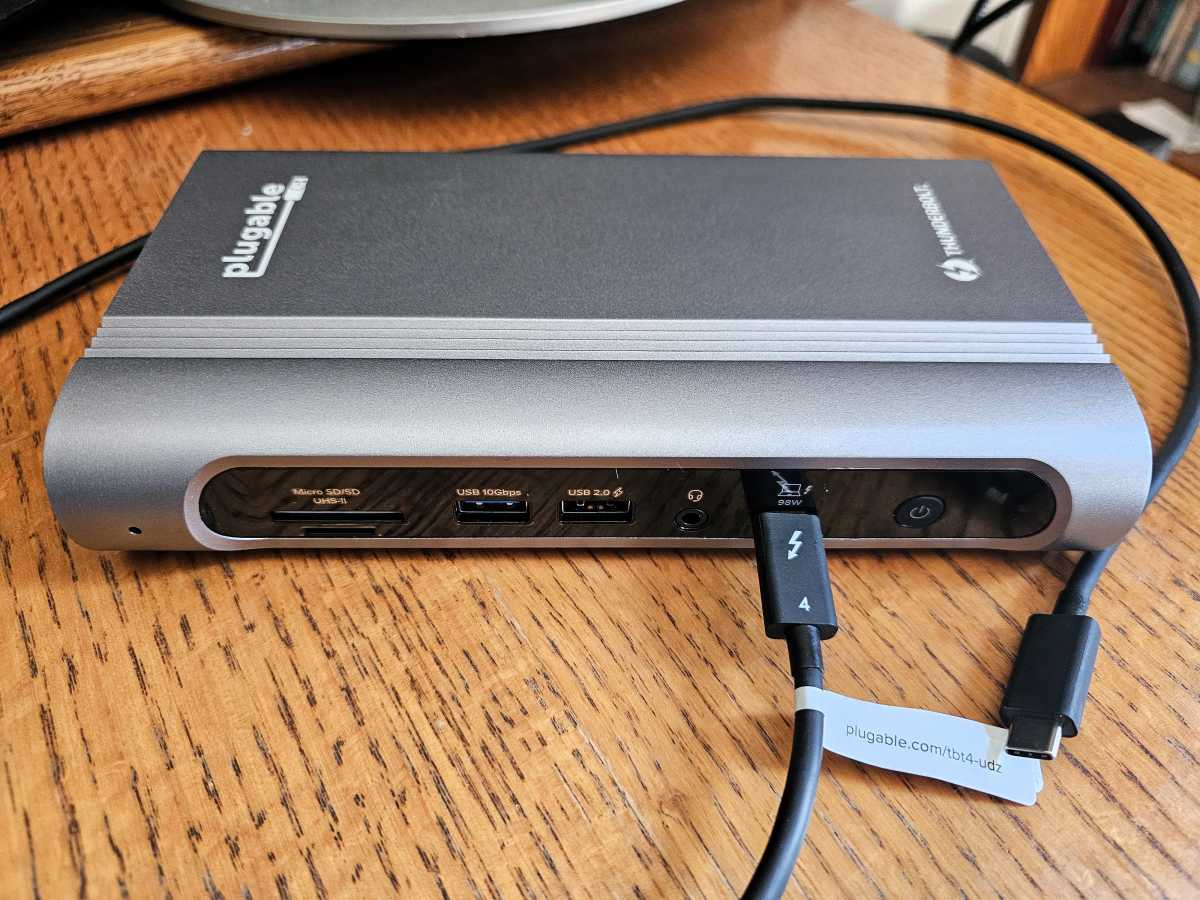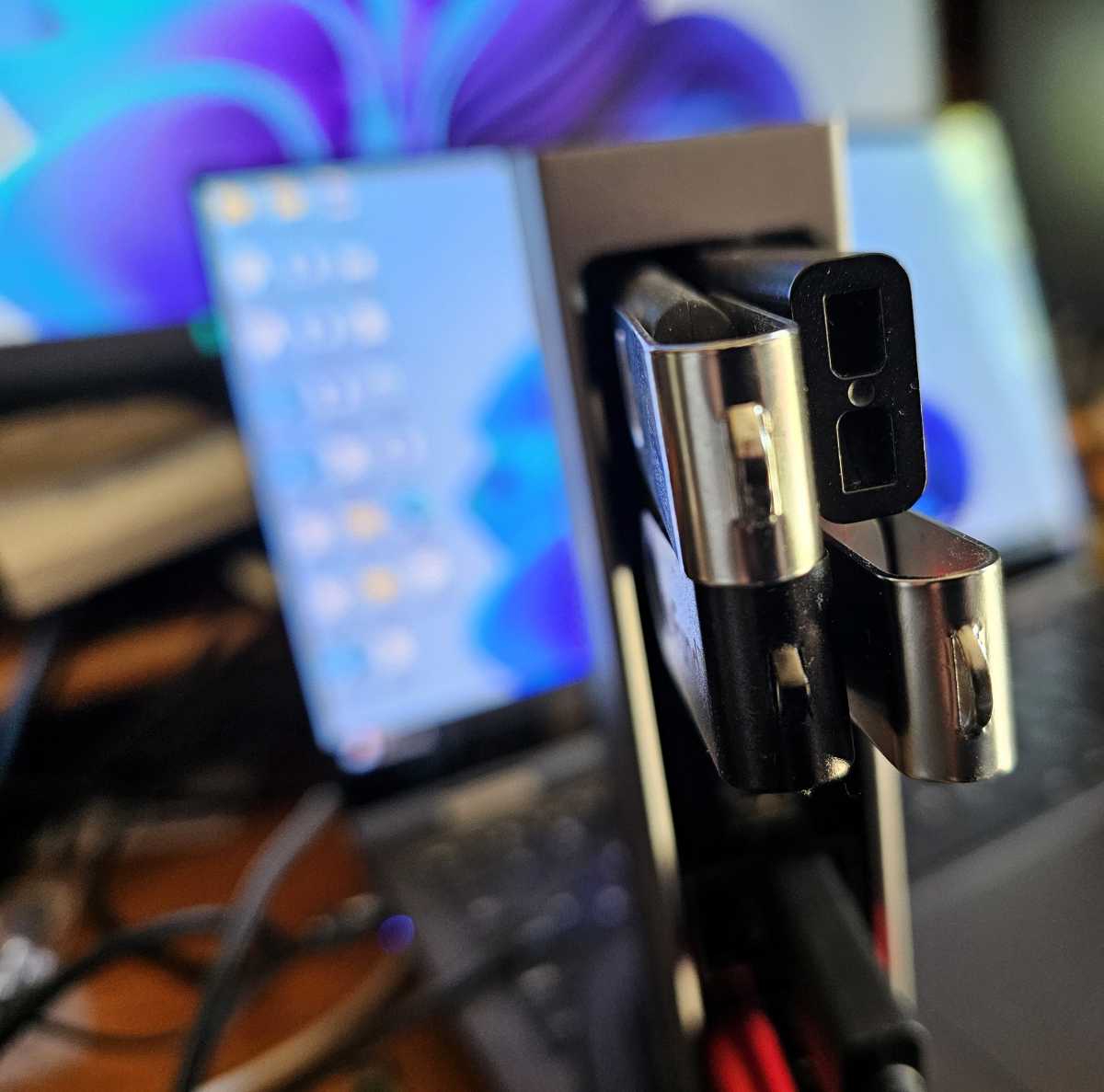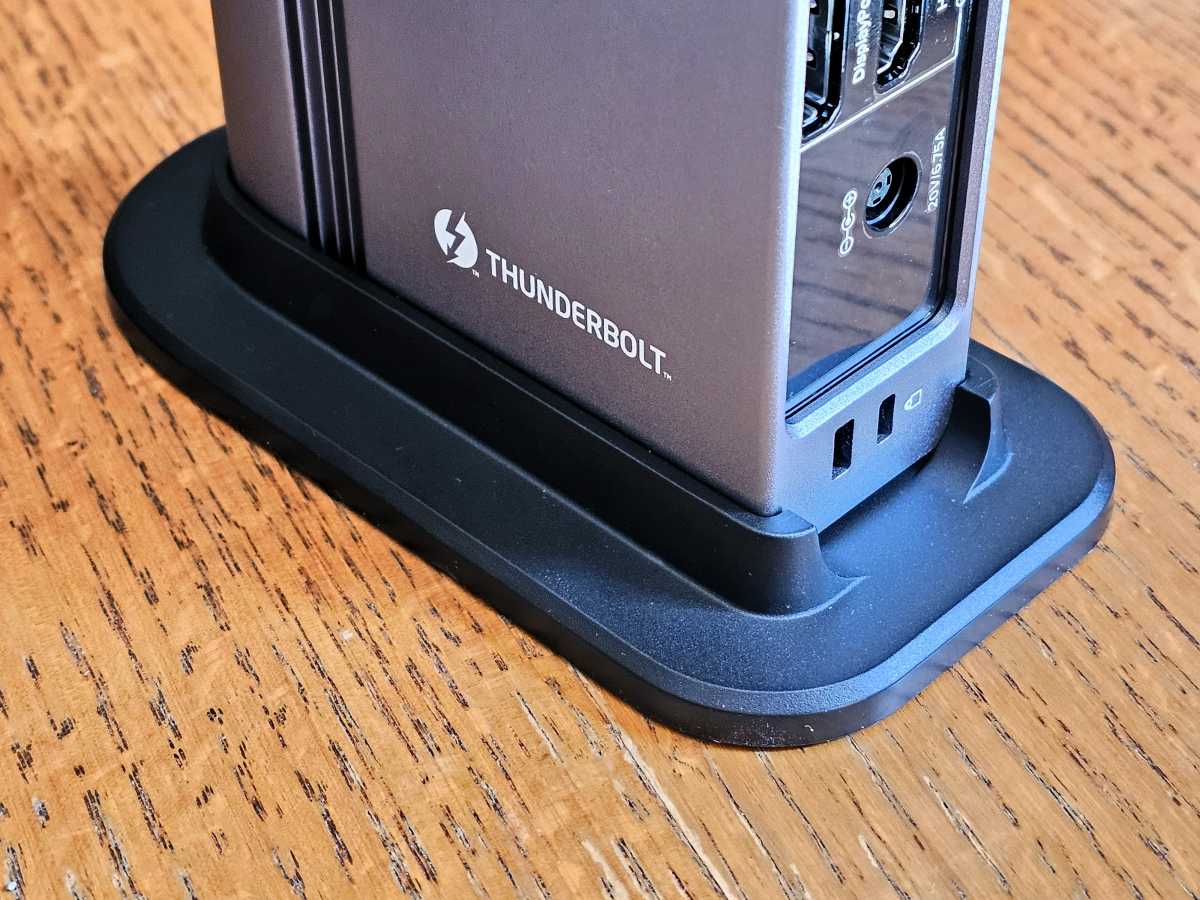Expert's Rating
Pros
- Can connect to four displays
- Tons of ports — no need to buy an adapter!
- You’ll love the vertical stand
Cons
- Expensive
- Some stability concerns
- Front USB-A port doesn’t deliver the rated power
Our Verdict
The Plugable Thunderbolt 4 and USB4 Quad Docking Station glitched a bit, knocking this ultrapremium docking station down. Its predecessor is a better value.
Best Prices Today: Plugable Thunderbolt 4 & USB4 Quad Display Docking Station (TBT4-UDZ)
Plugable’s Thunderbolt 4 and USB4 Quad Docking Station (TBT4-UDZ) offers the vast port selection and multiple display-port options I’d expect in a premium dock. But it doesn’t quite deliver where it counts, with stability proving to be an issue.
Plugable’s TBT4-UDZ is the Thunderbolt 4 version of the Plugable TBT3-UDZ, what I called the “Cadillac of Thunderbolt docks” at the time because of the plentiful port arrangement. It still tops our list of the best Thunderbolt docks. But there are very similar competitors now, as well.
On paper, Plugable’s Thunderbolt 4 and USB4 Quad Display Docking Station (TBT4-UDZ) is very similar to the Kensington Thunderbolt 4/USB 4 Quad Video Docking Station (SD5800T): similar names, similar features — but not similar in price. (Our sister site, TechAdvisor, has its own review of the Plugable Thunderbolt 4 & USB4 Quad Display Docking Station, too.) Kensington’s dock is priced at about $20 more on Amazon, but other retailers price Kensington’s dock significantly higher. Plugable’s dock is also remarkably similar to the Satechi Thunderbolt 4 Multimedia Pro Dock, a dock we loved which also commands a $299 price tag.
Plugable’s TBT4-UDZ has one strike against it: Because of the similarities between Thunderbolt 3 and Thunderbolt 4, you might want to consider the older iteration, instead. At about $200, Plugable’s TBT3-UDZ is about $100 cheaper than the newer TBT4-UDZ.

Mark Hachman / IDG
As the name suggests, you can use this dock with either an AMD Ryzen laptop, typically equipped with USB4 ports, or the Thunderbolt 4 ports that accompany and Intel-based laptop. (You can do this with virtually any rival dock, too; Plugable just calls it out.)
Plugable’s TBT4-UDZ offers gobs of ports
Plugable’s TBT4-UDZ mixes up the port arrangement compared to its predecessor, though. On the front is still a microSD/SD card slot — though both slots are now rated for 312MB/s UHS-II performance; on the TBT3-UDZ, only the full-sized SD card slot is. Both a 10Gbps USB-A as well as a 480Mbps USB-A port appear on the front of the dock, with the latter rated for 7.5W to charge external devices. A headphone jack, the Thunderbolt 4 port and a power button round out the front, plus a small yellow LED to signal power.
Plugable has pushed a second charging port (a 10Gbps USB-C port capable of 7.5W of USB Power Delivery) to the rear of the dock, which I’m not a fan of. Trying to fish around the back of the dock to insert a charging cable is harder than doing it on the front, and most phones charge with USB-C.
Otherwise, there are four USB-A ports on the rear of the TBT4-UDZ, two each for 5Gbps and 10Gbps — again an improvement. They’re tightly spaced, but USB keys and cables juuuust fit. There are also two DisplayPort 1.2 ports and two HDMI 2.0 ports, plus the power port and a 2.5Gbps Ethernet connection.
Provided that you’ve connected the dock to the right hardware, the dock can connect to four 4K displays (using all four ports) at 60Hz.

Mark Hachman / IDG
Physically, the TBT4-UDZ measures 7.7 x 4.1 x 1.4 inches., and a rated 22.7 ounces (646g). Like its predecessor, Plugable tosses in a vertical stand, which does wonders for minimizing the desk space it takes up. The stand is also perfectly stable from my experience, even fully loaded with various cables.
Speaking of cables, the TBT4-UDZ’s Thunderbolt 4 cable stretches a rather luxurious 3.25 feet or so, passing a rated 98W to the host — about 0.5 foot longer than the earlier dock, which passed a rated 96W. That’s about the maximum the current cables will allow.

Mark Hachman / IDG
Plugable TBT4-UDZ performance: Stability is a question
Provided that you’ve connected the dock to the right hardware, the dock can connect to four 4K displays (using all four ports) at 60Hz. The dock does so by using a combination of the Thunderbolt port, plus combining DisplayPort 1.4 HBR3 (High Bit Rate 3) with DSC (Display Stream Compression). If your laptop supports these, it should connect to four displays; otherwise, it can connect to the standard two 4K displays supported by Thunderbolt 4. (Note that you probably won’t be able to use your laptop’s display if you connect four external displays, and you’ll need to adjust your laptop’s settings so it remains on and fully operational when closed.)
I wouldn’t be surprised to discover that the rival Kensington SD5800T was manufactured by the same vendor. The port alignment is essentially identical, and the performance across multiple displays is too. The Kensington’s front-mounted USB-A charging port was supposed to deliver about 7.5W of power. It doesn’t. And neither does the Plugable TBT4-UDZ! Though rated at 7.5W, the Plugable TBT4-UDZ’s USB-A port delivers 3.8W, the same as the other USB-A ports.

Mark Hachman / IDG
Only the rear-mounted USB-C port delivers 7.0W, as it should. The dock itself delivers 86W to the laptop, which is pretty close to its rated power.
From a stability standpoint, I noticed the dock disconnect from both monitors twice in succession, just performing normal office work. While playing a game of Diablo IV, the dock disconnected from both monitors as well as the network, booting me from the game. Whether you’re working, chatting with a colleague, or gaming, that kind of thing is disruptive and a bit shocking.
Neither disconnection happened on my normal testing laptops, though the glitches did occur with a Microsoft Surface Laptop Studio 2, which includes two Thunderbolt 4 ports. Otherwise, I spent close to three days working with this dock, and experienced no other issues. (Just be sure to have your laptop up to date, as the dock didn’t deliver full 4K resolution with a laptop which needed to be updated.)
The performance of the dock was a bit less than I expected, across the board. In our streaming test, the dock dropped 30 frames out of 12,098 — a bit low but still average, and our 4K60 test stream was smooth. While running the PCMark storage benchmark, the dock dropped 38 frames — about double the Kensington SD5800T. The dock’s performance in the storage benchmark was lower than I’d like, too — 120MB/s versus 127MB/s. Is that a huge difference? Not really, no. But it’s still a bit slower.
The test I run where I copy a multi-gigabyte folder stuffed full of various files completed in 1 minute, 10 seconds, both while streaming and by itself. Again, the dock finished a couple seconds slower than the competition.
I didn’t have any problems with the Ethernet jack, the mic/headset cable, or the SD card slots.
Should you buy the Plugable TBT4-UDZ?
I’ve reviewed several Plugable docks, and the company has a well-founded reputation for quality. (A one-year limited warranty is included.) In this case, it falls a bit short.
I still think the Thunderbolt 3 (Plugable TBT3-UDZ) version of the dock is superior, because of the $100 or so discount. But I’m happy sticking with the Kensington docks as my recommended Thunderbolt 4 docking stations. I love the flexibility — who wouldn’t? But with competitors offering virtually the same thing, I’d opt for an alternative.





